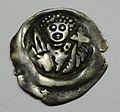Regional pfennig
The regional pfennig was a type of
The most important regional pfennigs include the Sachsenpfennig ("Saxon pfennig"), also known as the Wendenpfennig, and the Otto Adelheid Pfennig, the earliest mintings of which still followed the Carolingian standard. In particular, the later Sachsenpfennig and other regional pfennigs, such as the Regensburg Pfennig, the Vienna Pfennig, the Friesach Pfennig or the Krainer Pfennig, moved further and further away from their Carolingian model. There was no longer any uniformity in weights and fineness as there had been in the Carolingian monetary system. A pfennig or denarius from one region was no longer necessarily worth a pfennig in another region.
Gallery
-
Otto Adelheid Pfennig, reverse, Goslar Mint
-
Otto Adelheid Pfennig, obverse, Goslar mint
-
Regensburg Pfennig, 13th century, Ex-Dr. Robert Friedingen-Pranten
-
Carniolan Pfennig, 13th century (1218–51)
-
Vienna Pfennig, lion with breastplate, 14th century
-
Munich Pfennig, 14th century (1349–75)
-
Friesach Pfennig for Salzburg, bishop, obverse
-
Friesach Pfennig for Salzburg, reverse
References
- ^ Kluge (1974), p. 43.
Literature
- Bernd Kluge (2016). Münzen – Eine Geschichte von der Antike bis zur Gegenwart. Munich.
- Wolfgang Trapp (1999). Kleines Handbuch der Münzkunde und des Geldwesens in Deutschland. Reclam-Verlag, Stuttgart.









